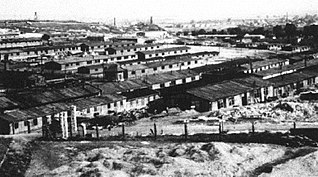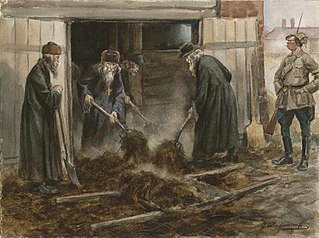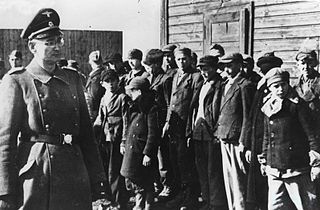Related Research Articles

A prisoner of war (POW) is a person who is held captive by a belligerent power during or immediately after an armed conflict. The earliest recorded usage of the phrase "prisoner of war" dates back to 1610.

During the later stages of World War II and the post-war period, Germans and Volksdeutsche fled and were expelled from various Eastern and Central European countries, including Czechoslovakia, and from the former German provinces of Lower and Upper Silesia, East Prussia, and the eastern parts of Brandenburg (Neumark) and Pomerania (Hinterpommern), which were annexed by Poland and the Soviet Union.

Organisation Todt was a civil and military engineering organisation in Nazi Germany from 1933 to 1945, named for its founder, Fritz Todt, an engineer and senior member of the Nazi Party. The organisation was responsible for a huge range of engineering projects both in Nazi Germany and in occupied territories from France to the Soviet Union during the Second World War. The organisation became notorious for using forced labour. From 1943 until 1945 during the late phase of the Third Reich, OT administered all constructions of concentration camps to supply forced labour to industry.

Ernst Friedrich Christoph "Fritz" Sauckel was a German Nazi politician, Gauleiter of Gau Thuringia from 1927 and the General Plenipotentiary for Labour Deployment (Arbeitseinsatz) from March 1942 until the end of the Second World War. Sauckel was among the 24 persons accused in the Nuremberg Trial of the Major War Criminals before the International Military Tribunal. He was found guilty of war crimes and crimes against humanity, sentenced to death, and executed by hanging.

Following the Invasion of Poland at the beginning of World War II, nearly a quarter of the entire territory of the Second Polish Republic was annexed by Nazi Germany and placed directly under the German civil administration. The rest of Nazi-occupied Poland was renamed as the General Government district. The annexation was part of the "fourth partition of Poland" by Nazi Germany and the Soviet Union, outlined months before the invasion, in the Molotov–Ribbentrop Pact.

The Generalplan Ost, abbreviated GPO, was Nazi Germany's blueprint for the genocide, extermination and large-scale ethnic cleansing of Slavs, Eastern European Jews and other indigenous peoples of Eastern Europe categorized as "Untermensch" in Nazi ideology. The campaign was a precursor to Nazi Germany's planned colonisation of Central and Eastern Europe by Germanic settlers, and it was carried out through systematic massacres, mass starvations, chattel labour, mass-rapes, child abductions and sexual slavery.

A labor camp or work camp is a detention facility where inmates are forced to engage in penal labor as a form of punishment. Labor camps have many common aspects with slavery and with prisons. Conditions at labor camps vary widely depending on the operators. Convention no. 105 of the United Nations International Labour Organization (ILO), adopted internationally on 27 June 1957, abolished camps of forced labor.

The German camps in occupied Poland during World War II were built by the Nazis between 1939 and 1945 throughout the territory of the Polish Republic, both in the areas annexed in 1939, and in the General Government formed by Nazi Germany in the central part of the country (see map). After the 1941 German attack on the Soviet Union, a much greater system of camps was established, including the world's only industrial extermination camps constructed specifically to carry out the "Final Solution to the Jewish Question".

Forced labour, or unfree labour, is any work relation, especially in modern or early modern history, in which people are employed against their will with the threat of destitution, detention, or violence, including death or other forms of extreme hardship to either themselves or members of their families.

Disarmed Enemy Forces is a US designation for soldiers who surrender to an adversary after hostilities end, and for those POWs who had already surrendered and were held in camps in occupied German territory at the time. It was General Dwight D. Eisenhower's designation of German prisoners in post–World War II occupied Germany.
Lager Borkum was a labour camp on Alderney, in the Channel Islands, named after the East Frisian Island of Borkum.
Lager Helgoland was a labour camp on Alderney in the Channel Islands, named after the Frisian Island of Heligoland, formerly a Danish and then British possession located 46 kilometres (29 mi) off the German North Sea coastline and belonging to Germany since 1890.

Extermination through labour is a term that was adopted to describe forced labor in Nazi concentration camps whose inmates were held in inhumane conditions and suffered a high mortality rate; in some camps most prisoners died within a few months of incarceration. In the 21st century, research has questioned whether there was a general policy of extermination through labor in the Nazi concentration camp system because of widely varying conditions between camps. German historian Jens-Christian Wagner argues that the camp system involved the exploitation of forced labor of some prisoners and the systematic murder of others, especially Jews, with only limited overlap between these two groups.

Arbeitseinsatz was a forced labour category of internment within Nazi Germany during World War II. When German men were called up for military service, Nazi German authorities rounded up civilians to fill in the vacancies and to expand manufacturing operations. Some labourers came from Germany but exponentially more from roundups (łapanka) in the German-occupied territories. Arbeitseinsatz was not restricted to the industry sector and to arms producing factories; it also took place, for example, in the farming sector, community services, and even in the churches.

Ostarbeiter was a Nazi German designation for foreign slave workers gathered from occupied Central and Eastern Europe to perform forced labor in Germany during World War II. The Germans started deporting civilians at the beginning of the war and began doing so at unprecedented levels following Operation Barbarossa in 1941. They apprehended Ostarbeiter from the newly-formed German districts of Reichskommissariat Ukraine, District of Galicia, and Reichskommissariat Ostland. These areas comprised German-occupied Poland and the conquered territories of the Soviet Union. According to Pavel Polian, although the Ostarbeiter from most occupied territories were predominantly men, of the "eastern workers" taken from occupied Soviet territories over 50% were women, and of those from Poland nearly 30% were women. Eastern workers included ethnic Ukrainians, Poles, Belarusians, Russians, Armenians, Tatars, and others. Estimates of the number of Ostarbeiter range between 3 million and 5.5 million.

The use of slave and forced labour in Nazi Germany and throughout German-occupied Europe during World War II took place on an unprecedented scale. It was a vital part of the German economic exploitation of conquered territories. It also contributed to the mass extermination of populations in occupied Europe. The Germans abducted approximately 12 million people from almost twenty European countries; about two thirds came from Central Europe and Eastern Europe. Many workers died as a result of their living conditions – extreme mistreatment, severe malnutrition and abuse were the main causes of death. Many more became civilian casualties from enemy (Allied) bombing and shelling of their workplaces throughout the war. At the peak of the program the forced labourers constituted 20% of the German work force. Counting deaths and turnover, about 15 million men and women were forced labourers at one point during the war.

The Alderney camps were camps built and operated by Nazi Germany during its World War II occupation of the Channel Islands. Alderney island had four forced/slave labour sites, including Lager Sylt, the only Nazi concentration camp on British soil during the wartime occupation.

Heuaktion was a World War II operation in which 40,000 to 50,000 Polish children aged 10 to 14 were kidnapped by German occupation forces and transported to Nazi Germany as slave labourers.

The Holocaust in Bulgaria was the persecution of Jews between 1941 and 1944 in the Kingdom of Bulgaria and their deportation and annihilation in the Bulgarian-occupied regions of Yugoslavia and Greece during World War II, arranged by the Nazi Germany-allied government of Tsar Boris III and prime minister Bogdan Filov. The persecution began in 1941 with the passing of anti-Jewish legislation and culminated in March 1943 with the detention and deportation of almost all – 11,343 – of the Jews living in Bulgarian-occupied regions of Northern Greece, Yugoslav Macedonia and Pirot. These were deported by the Bulgarian authorities to Vienna and ultimately sent to extermination camps in Nazi-occupied Poland.

SS-Truppenübungsplatz Heidelager was a World War II SS military complex and Nazi concentration camp in Pustków and Pustków Osiedle, Occupied Poland. The Nazi facility was built to train collaborationist military units, including the Ukrainian 14th Waffen SS Division "Galician", and units from Estonia. This training included killing operations inside the concentration camps – most notably at the nearby Pustków and Szebnie camps – and Jewish ghettos in the vicinity of the 'Heidelager'. The military area was situated in the triangle of the Wisła and San rivers, dominated by large forest areas. The centre of the Heidelager was at Blizna, the location of the secret Nazi V-2 missile launch site, which was built and staffed by prisoners from the concentration camp at Pustków.
References
- ↑ Pagenstecher, Cord (2010). "Chapter 12: 'We were treated like slaves.' Remembering Forced Labor for Nazi Germany". In Hörmann, Raphael; Mackenthun, Gesa (eds.). Human Bondage in the Cultural Contact Zone: Transdisciplinary Perspectives. E-content Generic Vendor. p. 281. ISBN 9783830973751.
- ↑ Jarská, Šárka (October 2010). "Czechs as Forced and Slave Labourers During the Second World War". In von Plato, Alexander; Leh, Almut; Thonfeld, Christoph (eds.). Hitler's Slaves: Life Stories of Forced Labourers in Nazi-Occupied Europe. Berghahn Books. p. 49. ISBN 9781845459901.